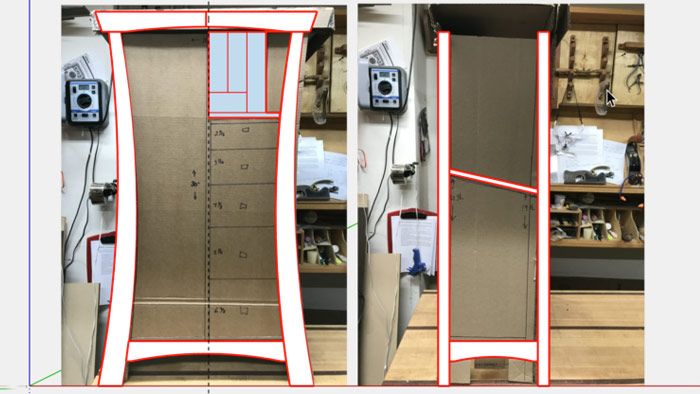SketchUp of a mock-up
When inventing a new design, Tim Killen doesn't see a need for a cardboard mock-up. He jumps right into SketchUp, guided by rough handmade pencil sketches.
This one is different and I’m sure controversial. I’m concluding that making cardboard mock-ups of planned furniture is a waste of time. There I said it…..
But here’s the background…..
Late last year I posted a blog here in Design. Click. Build. where I showed capturing an Oak Sideboard design. Here is a picture from “Home Furniture” magazine showing my trace-over of the design in SketchUp.

That trace-over captured the sizes, shapes and positions of all important components representing the actual design. This provided an excellent basis for completing a detailed design with all dimensions and joinery as shown below.

The detailed final design with all joinery.

This was an efficient and effective process for providing my student a complete set of drawings including full-size templates. His construction was excellent with a final product shown below.

Later, this student proposed building a one-off original design and provided pictures of a cardboard mock-up shown below. He asked if I could do the same SketchUp process of capturing the design from this cardboard mock-up, and producing the detailed design documents.

I agreed to his proposal and below you can see my trace-over to capture the sizing, position, shape, etc. of the important parts in SketchUp – the same process as used for the Oak Sideboard.

And from that trace-over, I quickly and confidently came up with a model shown here:

Unfortunately, this model, unlike the Oak Sideboard example, exposed all the omissions and deficiencies of the mock-up. The shape of the Legs would not work since there was no way to align hinges for the door. The centered partition had to be shifted to provide more space in the left side. The drawer section was going to be very difficult to build with all the shapes. The Top was all wrong, based on my interpretation of the mock-up. None of the components captured from the mock-up could be used. Quite a contrast to the experience for the Oak Sideboard.
Eventually after many back-and-forth discussions and hand sketches, these problems were all worked-out with a final model as shown below. With this model, the dimensioned drawings and full-size templates were extracted from SketchUp.

And here is the progress in the student’s shop.

I’m sure the final product will be a beautiful grand success. But I feel the design process was more difficult than necessary. I just don’t see the value of the cardboard mock-up, and using this flawed model, created extra work in SketchUp.
I must admit, I’m mostly reproducing existing museum pieces and have photos and sometimes diagrams in books, as a basis for starting in SketchUp. Obviously, a cardboard mock-up is useless in these cases.
But even when inventing a new design, I don’t see a need for a cardboard mock-up. I can jump right into SketchUp, albeit sometimes guided by a rough hand made pencil sketches specifying overall dimensions. If I need to see something full size, I can print it in SketchUp. This gives me a quicker detailed design ready for efficient shop work.
I do know that my student continues to strongly believe in the cardboard model. He is quick in making them and benefits from seeing a full-size representation of the piece. I could be wrong, but I think with additional skill in SketchUp, he may eventually skip that step.
Tim
KillenWOOD.com
Recognition and thanks to Morgan Strickland, my student, who challenges me with his projects, and is an excellent and enthusiastic cabinetmaker.
Fine Woodworking Recommended Products

Blackwing Pencils

Compass

Drafting Tools
























Comments
Tim,
I enjoyed this article and your other blogs posts. I have learned a lot over the years.
You say:
"I’m concluding that making cardboard mock-ups of planned furniture is a waste of time."
It doesn't have to be one vs the other: using SketchUp along with a possible mock-up can add value. You even said later that if you want to see full size you can print it from a SketchUp model. That full size print serves a similar purpose of a full size mockup. Iterations of the SU model can follow. Even car makers still make full size clay models.
With furniture, more so with new designs, there may be a need to understand the human relationship of a piece, experience first hand the subtle details and visual balance. Things just look different in real life than on a computer screen. So using both SketchUp and a full size mock-up can be useful for refinement of a design. That assumes the craftsperson has the depth of knowledge to use SketchUp for that purpose. For others, the cardboard/wood mock-up is the way to go.
Tim, there is another reason for a mockup - seeing a piece in the space where it will live. I am designing an LP cabinet for my entertainment room and wanted to see how the overall size fits where I want to put it. Admittedly, it is not a detailed mockup, and I will use SU for the details. My girlfriend has already made (excellent) comments, which she wouldn't have done with a SU model. And I do have a model of the room as well.
Log in or create an account to post a comment.
Sign up Log in